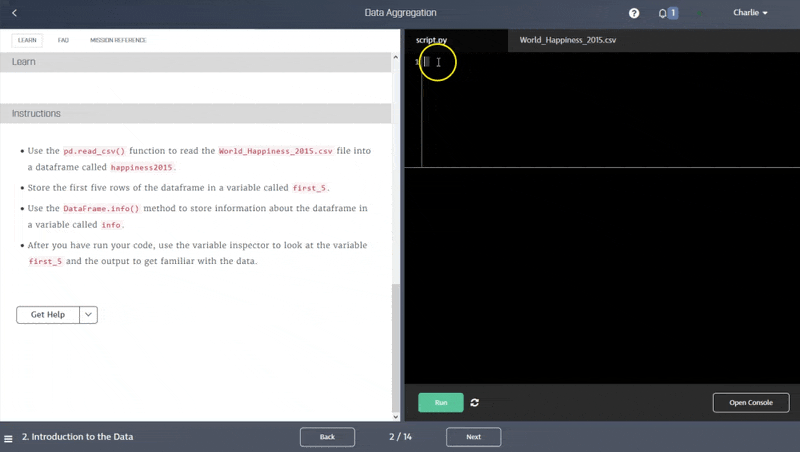
When it comes to learning data science online, students have a wide variety of options, but one of the most basic choices every student must make is whether they’d prefer to learn by reading text or by watching video.
Most MOOCs, because they’re based on the traditional college lecture format, present their information via video lectures. Even on education platforms not affiliated with universities, video lecturing is a common approach. Udemy’s top data science class, for example, includes a total of 41 hours in video lectures.
Other popular online data science and coding platforms teach differently, using minimal video and focusing on text-based instruction. Here at Dataquest, for example, we don’t use any video, presenting all of our lessons through the side-by-side text and interactive coding interface you see below.

Clearly, there’s a difference between watching a video and reading some text, but which of these approaches is better for learning data science?
Videos vs. Text
One recent and interesting experiment on this topic was conducted as part of MIT’s Integrated Learning Initiative (MITili) in 2018. Researchers asked students to sign up for learning sessions and then split them into groups, with one group consuming the session via video, and the other group reading a video transcript that had been edited to include some explanatory diagrams.
The morning after the session, both groups took the same assessment to test comprehension and retention, and both groups were surveyed about the learning method they preferred.
The researchers hypothesized that students would prefer watching the video to reading, and that video-watchers would also score better on the post-learning assessment. But they found precisely the opposite. More students preferred reading than preferred video (30% to 20%, the other 50% preferred other forms of learning like in-person lectures and hands-on learning). And students who’d consumed the material via reading performed slightly better on the post-learning assessment than students who watched video, although the study’s numbers were small enough that this difference was not statistically significant.
That’s a result that’s borne out in a number of larger and more scientific studies. The difference between learning via video and learning via reading, in and of themselves, doesn’t seem to have a statistical impact on how well students comprehend or retain the material.
So does that mean it doesn’t matter whether you learn data science by reading or by watching? No. When we’re talking specifically about data science, the media format alone isn’t the only difference between video- and text-based data science learning options.
The Other Big Difference in Data Science Learning Platforms
In the image below, take a look at Coursera’s UI for a Johns Hopkins data science course compared with to Dataquest’s UI. Clearly, there’s a big difference between the two platforms that goes beyond video: interactivity. In the Johns Hopkins class (left), students may opt to take notes in the right margin, but they’re not writing any code anywhere. In the Dataquest screen (right), students can read on the left, but they’re also being asked to apply what they’ve learned in the coding box on the right side of the screen before progressing to the next section.

This difference in presentation is understandable. Most students would struggle to write code while they were watching a video, which would result in a frustrating user experience, requiring a lot of pausing and rewinding. Moreover, Coursera and other general education platforms are not set up to support live coding or answer-checking, and implementing these features would be difficult and expensive. The end result of this is that they tend to present all of their information in video form, follow up videos with a short quiz, and hope that students apply what they’ve learned on their own time.
Dataquest and other text-based platforms typically take the opposite approach. We ask students to go hands-on and apply what they’ve learned directly after learning it. Since there’s always a correct answer in programming (either the code works correctly or it doesn’t), this hands-on approach also allows students to get instant feedback on how well they have understood and applied a concept.
This matters because when it comes to hands-on vs. passive learning, the science is very clear: hands-on learning is better.
Measuring the Value of Hands-On Learning
This is something we’ve known for a long time. In the 1980s, for example, a massive meta-study looked at 57 different studies on learning, across a total of more than 1,000 classrooms and 13,000 students and concluded that hands-on learners performed, on average 20% better than students who learned via a more traditional, lecture-based approach.
Those results are confirmed pretty consistently in more recent studies, too. A 2014 meta-study that looked at 225 previous studies found that in STEM courses, students who learned passively via lectures were 1.5 times as likely to fail.
Learning from a video-based platform doesn’t preclude applying your knowledge, of course. You can always watch a video and then open up a coding IDE on your laptop and start working on applying what you learned, referring back to the relevant spots in the video whenever you get stuck. But there are a few downsides to this:
- You’re less likely to actually do it, because it’s not mandatory and requires extra steps.
- You may not realize that you’ve gotten something wrong if your code runs but produces an incorrect answer, because there’s no answer-checking.
- You have to search through a video for answers when you get stuck, which can be frustrating and difficult.
- You’ll have to troubleshoot any technical problems you encounter yourself.
None of these are insurmountable obstacles, but they’re certainly worth considering when you’re choosing a data science platform to learn with. If you’re able to apply what you’ve learned quickly and conveniently, your progress will be more efficient and you’ll be less tempted to skip applying what you’ve learned because it’s an extra hassle.
The Platform That’s Right For You
How effectively you learn data science depends more on your personal approach than it does on the platform you choose. No single platform is going to offer right way to learn data science for everybody.
We do think that Dataquest is the best data science learning platform for most people, because of how clearly our content is presented and how quickly we get you hands-on coding with real-world datasets. But wherever you end up studying, be sure you’re getting the opportunity to regularly apply what you learn. It’s pretty clear from the science on this subject that you’re more likely to be successful in your learning goals if you spend less time listening and more time doing.
You can learn the basics of programming for data science on Dataquest for free, with no credit card required!